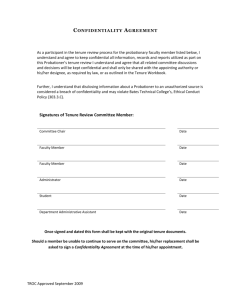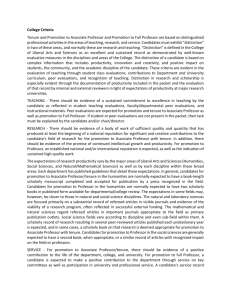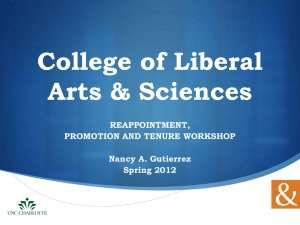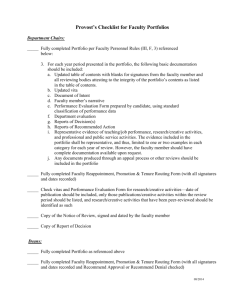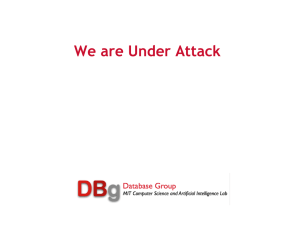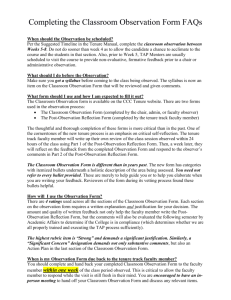1. What will be the timeline for transition? How will faculty
advertisement
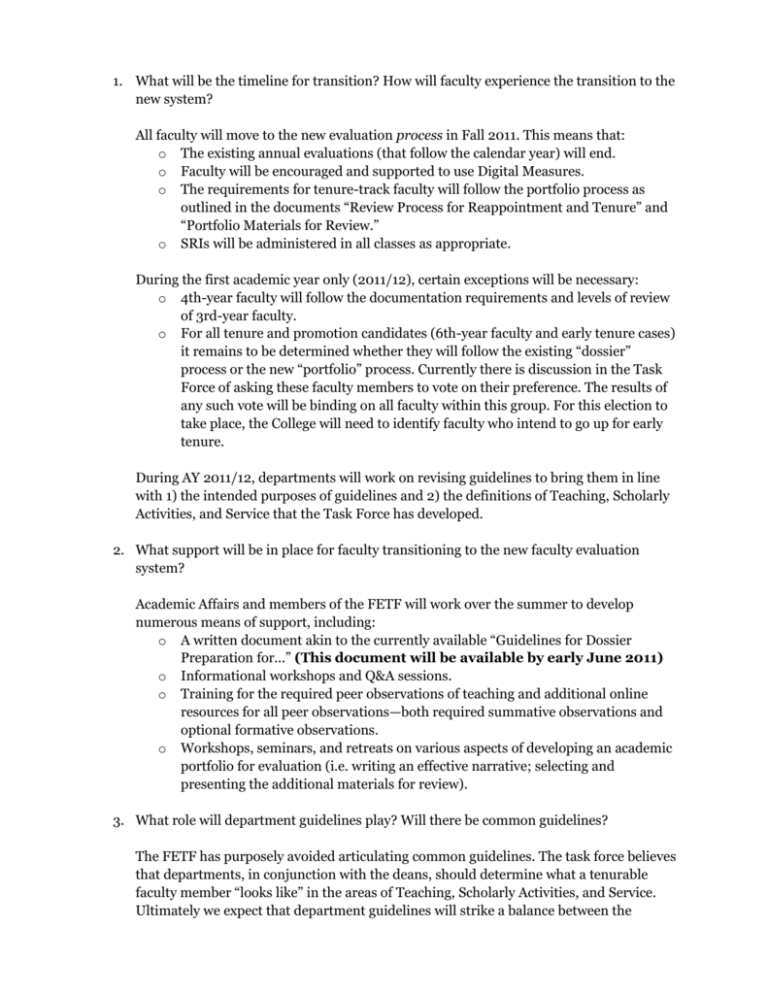
1. What will be the timeline for transition? How will faculty experience the transition to the new system? All faculty will move to the new evaluation process in Fall 2011. This means that: o The existing annual evaluations (that follow the calendar year) will end. o Faculty will be encouraged and supported to use Digital Measures. o The requirements for tenure-track faculty will follow the portfolio process as outlined in the documents “Review Process for Reappointment and Tenure” and “Portfolio Materials for Review.” o SRIs will be administered in all classes as appropriate. During the first academic year only (2011/12), certain exceptions will be necessary: o 4th-year faculty will follow the documentation requirements and levels of review of 3rd-year faculty. o For all tenure and promotion candidates (6th-year faculty and early tenure cases) it remains to be determined whether they will follow the existing “dossier” process or the new “portfolio” process. Currently there is discussion in the Task Force of asking these faculty members to vote on their preference. The results of any such vote will be binding on all faculty within this group. For this election to take place, the College will need to identify faculty who intend to go up for early tenure. During AY 2011/12, departments will work on revising guidelines to bring them in line with 1) the intended purposes of guidelines and 2) the definitions of Teaching, Scholarly Activities, and Service that the Task Force has developed. 2. What support will be in place for faculty transitioning to the new faculty evaluation system? Academic Affairs and members of the FETF will work over the summer to develop numerous means of support, including: o A written document akin to the currently available “Guidelines for Dossier Preparation for...” (This document will be available by early June 2011) o Informational workshops and Q&A sessions. o Training for the required peer observations of teaching and additional online resources for all peer observations—both required summative observations and optional formative observations. o Workshops, seminars, and retreats on various aspects of developing an academic portfolio for evaluation (i.e. writing an effective narrative; selecting and presenting the additional materials for review). 3. What role will department guidelines play? Will there be common guidelines? The FETF has purposely avoided articulating common guidelines. The task force believes that departments, in conjunction with the deans, should determine what a tenurable faculty member “looks like” in the areas of Teaching, Scholarly Activities, and Service. Ultimately we expect that department guidelines will strike a balance between the overarching mission of the College and what is appropriate for each discipline. So, while there will not be common guidelines per se, we shouldn’t expect there to be significant discrepancies between individual department guidelines. Furthermore, as the FETF recommendations state, the purpose of guidelines will be to establish the standard for a cumulative record of accomplishment over time (up to tenure, promotion, or post-tenure review). As such, department guidelines should undergo revision only rarely. 4. What will be the process for rewriting guidelines? Rewriting of department guidelines will take place during AY 2011/12. The FETF has not yet made recommendations for how the process will unfold, but we do expect that: o Departments will have most of the year to accomplish this. It will not be a rushed process. o There will be ample back-and-forth between the deans and departments. Departments will not feel as if they are undertaking this project in isolation. o It should be an inclusive process involving all tenure-track/tenured faculty within departments. 5. Will there be percentage values attached to each category of evaluation? No. Currently, weights and measures are used only in the annual evaluations that follow the calendar year; they are not used for reappointment, tenure and promotion decisions. (Members of the school and college RTP committees have confirmed that it is their current practice to review RTP cases holistically without regard to weights and measures). In that regard, and because we are ending annual evaluations that follow the calendar year, the Task Force does not believe that percentage values are necessary. Without weights and measures applied to each category, reviewers will be looking to see that candidates for reappointment, tenure, and promotion are meeting expectations in all 3 categories of evaluation and are showing evidence of professional growth. Candidates, for their part, will have the flexibility to excel in the category(ies) most important to them. Again, this does not represent a departure from current practices regarding reappointment, tenure, and promotion decisions. 6. I have put a lot of work into advising for my department. Will all this work now count for nothing in tenure and promotion decisions, since advising is no longer its own category? By including advising within the category of Teaching, the College is signaling that it values especially the developmental aspect of advising--advising that focuses on encouraging and guiding students toward career opportunities or toward graduate studies. The quality of advising should be what is reflected in portfolios. That said, we recognize that some faculty have invested considerable time into developing advising materials and protocols for their programs, and some faculty simply take on a disproportionate share of advising. It will be possible, even without a separate category for advising, to capture the quality of that work in portfolios. 7. How will the work I do on reassigned time be evaluated? In most cases, it will make sense for faculty to include the work they have completed on reassigned time as either teaching, scholarly activities, or service. For example, a grant proposal submitted to an external funding agency, completed on reassigned time, might be placed under Scholarly Activities, while work done as chair of a Faculty Senate standing committee, likewise completed on reassigned time, might be placed under Service. In still other cases, work done on reassigned time is more administrative in nature and should be evaluated on its own merits. In all cases, the FETF is proposing that all reassigned-time evaluations and reports be included in the 3rd and 6th-year portfolios. 8. Can a faculty member with a lot of reassigned time be penalized for having taught less than a full load? No. Evaluation of teaching is based on the courses taught. 9. What measures will be developed to protect against unfair evaluations? The Task Force is working on several means of ensuring fair evaluations: o There will be extensive “user training” for faculty and administrators at all levels of review on the principles and processes of the new evaluation system. o The Task Force is currently developing Handbook language to establish a “reconciliation process” for cases where there is disagreement between levels of review. The purpose of such reconciliation meetings will be to attempt to resolve differences before the case is forwarded to the President. o There will be continued oversight of the evaluation system to ensure that practices that run counter to the Handbook are corrected. 10. Why is the definition of “Service” lacking the level of detail found in the definitions of “Teaching” and “Scholarly Activities”? The Task Force initially desired to keep this definition both succinct and broadly encompassing because we felt that any attempt to capture exhaustively all the forms that service could take would inevitably exclude something we had not considered. By keeping the definition succinct, the Task Force never intended to diminish the relative importance of Service. Despite our intentions, the feedback we have received suggests that faculty desire additional elaboration on what “Service” is, similar to how the definitions of “Teaching” and “Scholarly Activities” are elaborated upon. Most recently, the FETF has developed the following definition of service: Service Faculty engage in service when they participate in the shared governance and good functioning of the institution; service to the institution can be at the program, department, school, or college level. Beyond the institution, faculty engage in service when they use their disciplinary and/or professional expertise and talents to contribute to the betterment of their multiple environments, such as regional communities, professional and disciplinary associations, non-profit organizations, or government agencies. Examples of service might include: Committee participation Committee leadership Program or department contributions Board participation Volunteer consultancies Contributions to disciplinary associations 11. Will the portfolio approach make it easier for weak performing faculty to “slip through”? No. It is unlikely that under-performing faculty will be able to “slip through” unnoticed. It is true that the portfolio system allows faculty to put their best foot forward and to showcase their most important accomplishments. Still, all faculty will be expected to meet their department guidelines for tenure. The CV, as an encompassing and cumulative document within the portfolio, should make it possible to identify those cases when faculty do not meet the department guidelines for tenure. Portfolios are essentially evidence-based documents, just like an academic article where the author selects evidence to make a case for his/her thesis. 12. Is the Task Force establishing a system that will allow for merit-based pay adjustments? The Task Force has carefully avoided questions concerning compensation. It has been our priority to establish the best evaluation system possible that meets our desire for a “meaningful” system (one that uses valid measures to capture the quality of faculty work, allows faculty the flexibility to make the best case for themselves, and reduces “busy work”). Our work neither precludes nor renders inevitable any future decision regarding merit-based pay adjustments. 13. What will happen to annual evaluations of tenured faculty, the process for promotion, and post-tenure review? The Task Force recommends that annual evaluations (those that follow the calendar year) end. The next steps in the process of revising faculty evaluation will include developing recommendations for promotion and for post-tenure review. It is likely that those processes will be similar to the portfolio process developed for tenure-track faculty, where faculty will have options to make their strongest case. Questions related to proposed SRI instrument 14. Is the college making the evaluation of teaching more complicated by substituting openended questions (eliciting qualitative responses) for scaled items (eliciting quantitative responses)? The summative portion of SRIs (the portion intended for evaluation purposes) has a reduction in the number of scaled items from 4 to 2. There is no evidence that this reduction diminishes the ability of the evaluative portion of the SRI to capture the relevant instructional dimensions of teaching. Where we see significant replacement of scaled items (quantitative) by open-ended questions (qualitative) is in the “Teaching Improvement” section of the SRI. This section is not intended for evaluation purposes, and the student responses to these questions “belong” to the faculty member to use for formative purposes. 15. Why did the FETF stay with the same 6-point rating scale as used on the current Instructional Assessment instrument? The subcommittee that developed the instrument intentionally sought to retain a degree of continuity with the existing instrument so that some longitudinal data can be preserved. Thus, we retained 2 of the 4 items from the existing Instructional Assessment instrument that are used for evaluation, and we preserved as well the same 6-point Likert scale. 16. Can SRIs be administered online? There are good reasons for moving the SRI to online administration, not least of which is that the instrument lends itself very well to online administration. However, it is widely documented that response rates tend to fall when SRIs are administered online rather than in class on paper. We need to be sure that the fall in response rates will not be so severe as to render SRI results unrepresentative. We expect to begin the process of carefully moving SRIs online by piloting certain programs or departments in Fall 2011. 17. Does the evaluation of teaching rely too much on SRI results? This is a question of judgment, but the Task Force believes that enough additional ways are available to capture the work we do and the results we attain as teachers that we are not placing too heavy a reliance on SRIs. For example, even though peer observations are optional, other than the one required summative peer observation in the 6th year, faculty have the option to include additional observations in both their 3rd and 6th year portfolios as a counter-weight to SRIs. Departments, too, can establish within their guidelines expectations and protocols for peer classroom observations beyond what is required at a minimum for all faculty.
